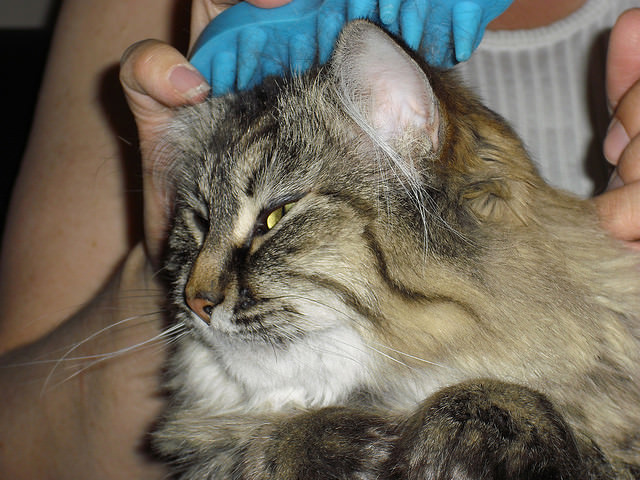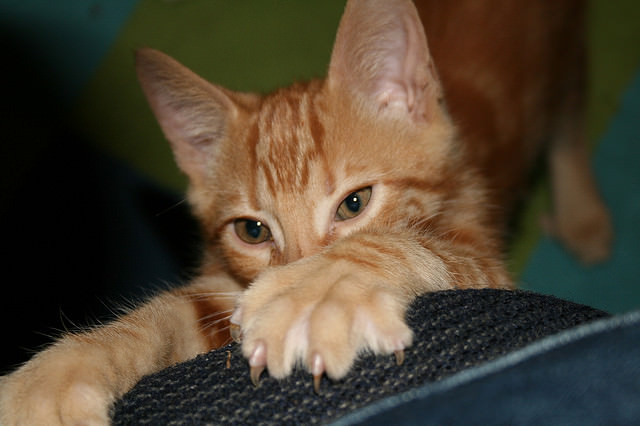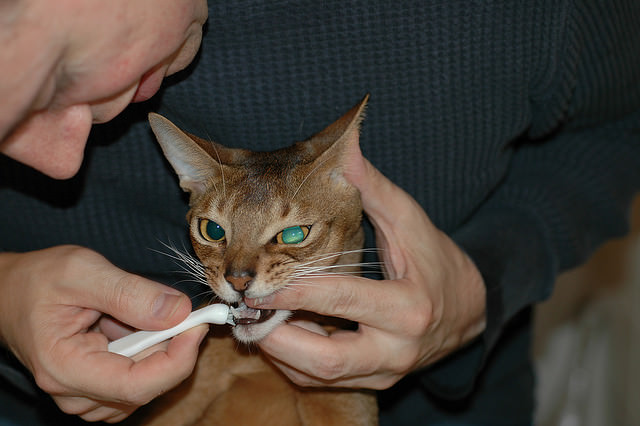Cats are notorious for being impeccable groomers, but sometimes they need a bit of extra help. Some of the most useful aspects of grooming– water, restraint, etc.– can make your cat anxious and desperate to escape. Seek out a professional groomer if your cat puts up a real fight when you attempt to groom her since grooming an angry or thrashing cat can cause injuries to either or both of you. For more amicable kitties, here are some tips to make the process as easy and stress-free as possible.

Image: kaelin via Flickr
Bathing
Most indoor cats won’t need to be bathed on a regular basis since their regular grooming habits should remove most knots, debris, and excess oil. Cats are curious creatures, though, and even well-behaved ones can find their way into sticky or stinky messes sometimes. Cats with certain health conditions (cats who are overweight or have joint pain, for instance) may need to be bathed more often if they can’t comfortably reach certain parts of their bodies.
- Plan baths during times of the day when your cat is the most mellow. For most cats this means after a meal or an exceptionally exhausting play session.
- Clip her nails first (see below) to avoid getting shredded in the process.
- Use a hand-held sprayer, pitcher, or plastic cup (nothing that will shatter if she knocks it out of your hand) to gently wet her and easily focus the water to certain parts of her body.
- Use a cat specific shampoo. A human shampoo can dry her skin or may contain ingredients that are toxic to cats.
- Use lukewarm water.
- Make sure all of the shampoo gets rinsed off. Residue can irritate her skin.
- Consider using a waterless shampoo to avoid water altogether. Or if she just needs a quick cleanup, use cat-specific wipes.
- Avoid wetting her face. You can use a damp washcloth if necessary.
- Wrap her in a large, cozy towel afterwards and help her dry off in a warm place.
- Reward her with treats so she associates the experience with something positive.

Image: Jon Ross via Flickr
Brushing
Brushing helps remove tangles, distribute natural oils, and improve your cat’s circulation. Some cats love it because it reminds them of being groomed by their mamas as kittens, but some are more skeptical.
- Let her sniff the brush and rub against it before you start a brushing session. Some cats just need to be familiar with the brush before it’s touching them.
- Brush in the direction her hair grows, working from her head to her tail.
- Use a mat splitter to easily release unruly knots. It’ll be less painful for her and less aggravating for you.

Image: Lindsey Turner via Flickr
Nail clipping
Keeping up with regular nail clipping is one humane alternative to declawing (which you should never, ever do). Only clip your cat’s nails if you’re sure you know what you’re doing and that you can do it safely.
- Like bathing, plan nail clipping sessions around when your cat is most likely to be relaxed.
- Get your cat used to paw touching a week or two before you clip for the first time. Gently massage her paws for a few seconds a couple times a day. Gently rub her paws and paw pads, and press her paws to extend her nails.
- Get her used to the sound of the clippers before you attempt to clip her nails. The ASPCA recommends: “Sit her on your lap, put a piece of uncooked spaghetti into the clippers and hold them near your cat. (If she sniffs the clippers, set a treat on top of them for her to eat.) Next, while massaging one of your cat’s toes, gently press her toe pad. When the nail extends, clip the spaghetti with the clippers while still holding your cat’s paw gently. Now release her toe and quickly give her a treat.”
- Be very careful not too clip too far down. See the pink part of her nail? That’s where the nerves and blood vessels live. Only clip the white part! Clipping too far is painful and dangerous. Always keep styptic powder on hand while clipping nails, just in case you accidentally cut too far. It’ll help stop the bleeding.

Image: John Morton via Flickr
Tooth brushing
Brushing your cat’s teeth is an important part of keeping her teeth and gums healthy.
- For a week or two leading up to her first brushing, get her used to having her mouth touched by gently lifting her lip and massaging her gums with your fingers.
- Once she’s used to having her mouth touched, dab a bit of cat-specific toothpaste on her lips so she can get familiar with the taste. Never use human toothpaste, which can contain ingredients that are toxic to cats.
- Use a cat-specific toothbrush. It’ll be smaller than your human version and the bristles will be softer.
